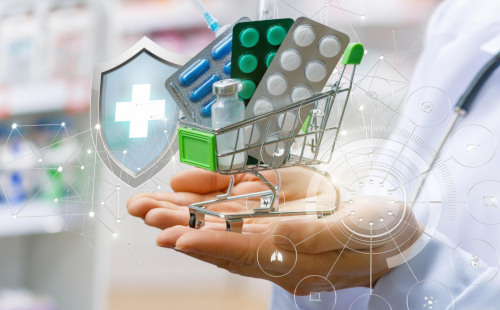Nateglinide is used in solo or in conjunction with alternative remedies to manage elevated levels of glucose in the bloodstream in combination with a suitable nutritional plan and physical fitness regimen. Its utilization is evident among individuals diagnosed with type 2 diabetes. Regulating high blood sugar levels aids in the avoidance of impairments to the kidneys, vision impairment, complications with nerves, amputations, and challenges with sexual performance. Maintaining proper control over diabetes further diminishes the probability of experiencing a cardiovascular incident or cerebral infarction. This substance operates by inducing the body to generate an increased quantity of insulin. Insulin constitutes a natural compound facilitating the effective utilization of sugar derived from the dietary intake.
GUIDE ON USAGE:
Familiarize yourself with the Patient Information pamphlet in case it's on hand at your local drugstore prior to embarking on the use of nateglinide and at every refill occasion. For any uncertainties, confer with your healthcare provider or pharmacist. Ingest starlix orally 1-30 minutes prior to each primary meal, typically thrice daily, or based on your healthcare provider's instructions. Consume this medication no less than 30 minutes before eating. If you are opting out of a meal, abstain from taking a dose of the medication. An increased dose of starlix might be required for those consuming liquid meals to maintain optimal blood sugar levels.
Seek counsel from your physician to delve deeper into the matter. The prescribed amount is determined by your health status, frequency of daily meals, and reaction to therapy. Adhere to the guidance of your medical provider in using starlix consistently to maximize its advantages. meticulously adhere to the medication regimen, dietary plan, and physical activity schedule advised by your physician. Monitor your blood sugar levels routinely as instructed by your physician. Record the outcomes meticulously and discuss them with your physician. This step is crucial to ascertain the appropriate dosage.
Inform your physician immediately if your blood glucose levels tend towards the extreme ends of the spectrum. Modification of your therapeutic regimen may be imperative. Adverse reactions may manifest as an increase in body weight. Should this phenomenon endure or exacerbate, contact your healthcare provider or dispensing chemist without delay. It should be noted that the administration of starlix has been sanctioned on the grounds that the advantages outweigh the likelihood of adverse effects. The majority of starlix users do not encounter severe side effects. Nateglinide has the potential to induce episodes of low blood sugar (hypoglycemia), particularly when concomitantly using other antidiabetic agents.
Excessive intake of alcoholic beverages, insufficient caloric intake from meals, or engaging in intense physical activity beyond the norm can also result in decreased blood sugar levels. Manifestations may consist of shivering, icy perspiration, lightheadedness, lethargy, tremors, rapid heartbeat, feebleness, migraine, loss of consciousness, pins and needles sensation in the extremities, or a sensation of hunger. It is advisable to have on hand glucose pills or gel for managing low blood sugar. In the absence of these dependable sources of glucose, rapidly elevate your blood sugar by consuming a rapid sugar source like granulated sugar, nectar, sweets, or imbibing a glass of fruit juice or non-diet carbonated beverage.
Consult either your physician or pharmacist to inquire about the necessary steps in the event that a meal is skipped. Signs of elevated blood sugar (hyperglycemia) encompass a sense of thirst, heightened frequency of urination, mental disorientation, drowsiness, facial redness, accelerated respiration, and a fruity exhalation. Should these indications manifest, do not hesitate to inform your physician promptly. It may be essential for your medical provider to modify the type or dosage of your prescribed diabetes medications. Instances of an exceedingly severe allergic reaction to this medication are rare. Nevertheless, promptly seek urgent medical assistance if you experience any of the subsequent symptoms indicating a severe allergic reaction: skin rash, itching or swelling (particularly in the facial region, tongue, or throat), acute vertigo, or respiratory distress.
This list does not cover all the potential side effects. Should you experience any other reactions not mentioned here, seek guidance from your healthcare provider or pharmacist. In the United States, reach out to your doctor for professional insight on side effects.
INTERACTIONS WITH OTHER DRUGS:
The way your medications function or the risk of severe side effects may be altered by drug interactions.
This information is not exhaustive in terms of potential drug interactions. It is important to maintain a comprehensive inventory of all substances you are using (both prescribed and over-the-counter medications, as well as herbal products) and discuss it with your healthcare providers. Refrain from initiating, discontinuing, or adjusting the dosage of any medications without the consent of your healthcare provider. Various medications have the potential to impact your blood sugar levels, complicating its management. Instances of such medications include corticosteroids (like prednisone), psychiatric drugs (such as olanzapine), fluoroquinolone antibiotics (such as ciprofloxacin), and others.
Monitor your blood sugar levels regularly as instructed and communicate the findings with your physician. If you experience any signs of elevated or reduced blood sugar, promptly inform your doctor. Your physician might need to modify your diabetes treatment, workout regimen, or dietary plan. Take a close look at the packaging of all over-the-counter medications you use (such as remedies for coughs and colds) as they could contain substances that impact your blood sugar levels. Consult your pharmacist regarding the appropriate usage of these products. Beta-blocker drugs (e.g., metoprolol, propranolol, glaucoma eye drops like timolol) can potentially alleviate the rapid or irregular heartbeat typically associated with low blood sugar (hypoglycemia).
The drugs do not alter symptoms like lightheadedness, cravings, or perspiration caused by decreased blood sugar levels. Urine test outcomes for sugar or ketones may be influenced by various other prescriptions. Seek advice from your healthcare provider or drug dispenser to obtain more detailed insights.

